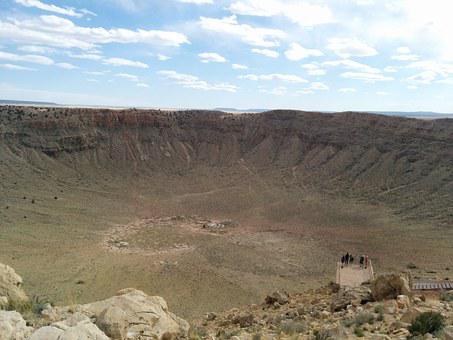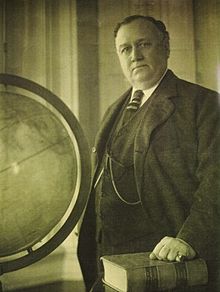In the solar system, impact craters are the dominant geographic features of many solid solar system objects such as the Moon, Ganymede, Callisto, and other small asteroids. Some planets and moons experience surface geological processes such as Earth, Europa, Venus, and Titan. Due to erosion, the impact craters are buried or transformed by tectonics.
Barringer Crater, also known as Meteor Crater, is located approximately 37 miles (60 km) east of Flagstaff and 18 miles (29 km) west of Winslow in the desert of Northern Arizona, United States. Before this meteorite impact crater was named Barringer Crater, it had several names. The fragments collected from this impact crater are known as Canyon Diablo Meteorite, named after Canyon Diablo. However, this impact crater site has been privately owned by the Barringer family to this day through the Barringer Crater Company.
Formation of Crater
Barringer Crater or Meteor Crater was created during the Pleistocene epoch which was about 50,000 years ago. It was the time when the climate of the Colorado Plateau was wetter and cooler. It was an open grassland dotted with forests which made it a habitat for giant ground sloths and mammoths.
The meteorite that caused an impact crater in Northern Arizona was a nickel-iron meteorite. The diameter of the meteorite was about 50 m (160 ft). However, the velocity of the meteorite has been a debate. Initially, it was suggested that the meteor was traveling at a speed of 20km/s (45,000 mph). Later on, it was considered slower than the initial observation that the meteorite was traveling at the speed of 12.8 km/s (29,000 mph).
The earth’s atmosphere vaporized half the volume of the meteorite during the descent. However, the meteorite was still able to produce impact energy of 10 megatons TNT. During an impact, the meteorite was completely vaporized leaving little debris in the crater.
Due to natural erosion, the rim of the crater has lost 15 to 20 meters (50 to 65 ft) height at the crest of the rim. Similarly, the crater basin is thought to have about 30 meters (100 feet) of post-impact deposition from lake sediments and alluvium.
The impact craters visible on the Earth are countable but most of them have been obliterated because of the geological process of erosion. However, Barringer Crater has been preserved by the Barringer Crater Company for ages.
Discovery and Investigation
After the discovery of this impact crater in the 19th century by the American settlers, it became the center of attention of scientists. Initially, the impact crater was given several names such as Coon Butte, Meteor Mountain, Crater Mountain, and Meteor Crater. However, it was named Barringer Meteorite Crater by the Meteoritical Society because it was first discovered by Daniel M. Barringer.
It was the first suggestion by Barringer that it was a meteorite impact crater. In the early 20th century, the impact crater was filed by the Barringer Family as a mining claim. The meteorites collected from the impact crater and its surroundings were named Canyon Diablo meteorites because the nearest area was Canyon Diablo, Arizona.
The impact crater was suggested as a volcanic crater due to the San Francisco volcanic field 40 miles (64 km) to the west.
Daniel M. Barringer
In 1903, Daniel M. Barringer, a businessman, and mining engineer suggested that the crater was caused by the impact of a large iron-metal meteorite. The Standard Iron Company owned by Barringer claimed the land for mining. In the same year, they received a land patent signed by Theodore Roosevelt for 640 acres (1 square mile, 260 ha) around the impact crater.
The claim was divided into four quadrants running from the center clockwise from the northwest named Saturn, Jupiter, Mars, and Venus. In 1906, Roosevelt authorized the establishment of a post office named Meteor, Arizona. Previously, which was previously 30 miles (48 km) away in Winslow, Arizona. The new post office was located 6 miles north of the crater.
Between 1903 and 1905, The Standard Iron Company conducted research on the origin of the crater. It was concluded by the company that the crater was caused by an impact. As a result, Barringer and his associate, Benjamin Chew Tilghman, a mathematician and physicist documented the theory of impact in papers and submitted it to the U.S. Geological Survey in 1906. The document was published in the proceedings of the Philadelphia Academy of Natural Sciences.
The arguments by Barringer were met with skepticism. At that time, there was a reluctance to consider the role of meteorites in the geology of Earth. To bolster his theory, he located the remaining parts of the meteorite. At the time of discovery, the surroundings near the impact crater were covered with 30 tons of large oxidized iron meteorite fragments.
It was believed by Daniel M. Barringer that most of the meteor could still be found under the impact crater floor. However, there was no understanding or explanation of meteorites hitting the Earth’s surface. As a result, Barringer did not know that the meteor had been vaporized during an impact. He spent 27 years looking for a valuable metal under the impact’s floor. The impact crater’s floor was drilled 419m (1,375 feet) but there were no significant traces of meteor deposits.
In 1929, Barringer Crater Company hired F.R. Moulton, an astronomer to investigate the physical events of meteors making an impact. It was concluded by Moulton that the impactor probably weighed 300,000 tons. If a meteor was of such weight, the heat generated due to an impact would have vaporized the impactor instantly.
Where is Barringer Crater?
Barringer Crater is one of the top 10 craters on Earth. It is located at an elevation of 1,719 m (5,640 feet) above sea level. The diameter of the impact crater is 1,200 m (3,900 feet) with a depth of about 170 m (560 feet). It is surrounded by a ledge that rises 45 m (148 feet) above the surroundings.
The center of the crater is filled with 210 to 240 m (690 – 790 ft) of debris resting on the bedrock of the crater. One of the interesting features of Barringer Crater is the square outline. It is thought to be caused because of existing regional joints in the strata of the impact site.
Recent History of Barringer Crater
- During the 1960s and 1970s, the Barringer Crater was used to train the NASA astronauts to prepare them for Apollo Missions to the Moon which is one of the iconic events in the history of space exploration.
- On August 8, 1964, two commercial pilots in Cessna 150 flew over the crater at a lower altitude. After crossing the rim, they were unable to maintain the level of flight. The pilot attempted to circumvent the crater to cross the rim. As a result, the aircraft stalled during the climb and crashed into the rim. It was reported that the plane ran out of fuel but this is untrue.
However, the aircraft burst into flames but the occupants survived the hit. A small portion of wreckage was not removed from the crash site which is still visible.
- In a 1984 film, Starman starring Charles Martin Smith, Karen Allen, and Jeff Bridges, the Barringer Crater was the protagonists’ destination on their cross-country journey.
- In 2006, METCRAX (Meteor Crater Experiment) studied the diurnal accumulation and decay of basin or cold air pool temperature inversions and associated physical and dynamical processes that explain their structure and morphology scalably.
Barringer Crater – A 50,000 Years Old Impact Crater
A meteor from outer space struck the Earth’s surface 50,000 years ago which is now Northern Arizona. This impact crater is named after a businessman and mining engineer Daniel Moreau Barringer. Initially, it was believed that this crater was due to the San Francisco volcanic field. However, Barringer was able to declare it as an impact crater. The Standard Iron Company owned by Barringer got a permit for mining at the crater site. It was to mine the valuable metal from the floor of the crater
Barringer Crater is located in Arizona, United States. The diameter of the impact crater is 1200 m and 170 m deep. The ring of the impact crater rises 45 m from the surroundings. Barringer Crater is one of the many impact craters in the world that are preserved well. However, the Barringer Crater Company has been able to preserve the crater. Furthermore, Barringer Crater gets hundreds and thousands of visitors each year via Meteor Crater and Barringer Space Museum visitor center.






